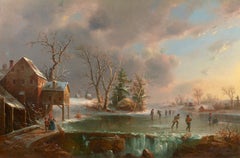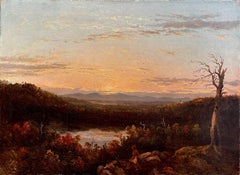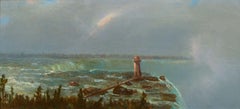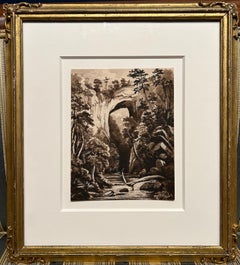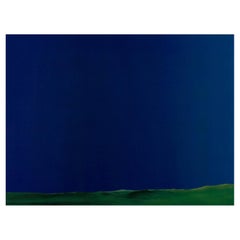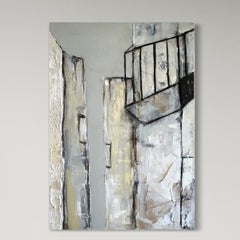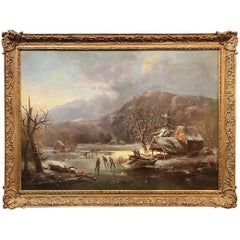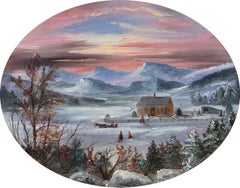Régis François Gignoux Landscape Paintings
to
1
1
1
1
Overall Width
to
Overall Height
to
4
3
1
2
1
1
1
1
4
3
2
2
1
4
669
600
314
229
4
4
Artist: Régis François Gignoux
Skaters on a Frozen Pond
By Régis François Gignoux
Located in New York, NY
Régis François Gignoux, a French-born artist trained at the Académie des Beaux-Arts under Paul-Hippolyte Delaroche, settled in New York and by 1844 opened a studio in the city, becom...
Category
19th Century Régis François Gignoux Landscape Paintings
Materials
Canvas, Oil
Oil Landscape of a Mountain Sunset
By Régis François Gignoux
Located in Fredericksburg, VA
Régis François Gignoux (1816–1882) was a French-American landscape painter known for his contributions to the Hudson River School. Gignoux quickly became an integral part of the Amer...
Category
Mid-19th Century Hudson River School Régis François Gignoux Landscape Paintings
Materials
Canvas, Oil
Niagara Falls
By Régis François Gignoux
Located in New York, NY
Signed lower left: R. Gignoux
Category
19th Century Hudson River School Régis François Gignoux Landscape Paintings
Materials
Oil
Watercolor of Natural Bridge, VA
By Régis François Gignoux
Located in Fredericksburg, VA
Régis Francois Gignoux was a distinguished nineteenth-century artist whose work illuminated the sublime aspects of the American landscape. He was born in Lyon, France and trained at the Academie des Beaux-Arts in Paris, where his instructor, the history painter Paul-Hipployte Delaroche, encouraged his interest in landscape painting. He traveled to the United States in 1840, and immediately showed interest in American Landscapes. He immediately settled in New York and painted many well known sites of the United States: Niagara Falls, the Catskill Mountains, Mount Washington, and Mammoth Cave, Kentucky. He is most famous for his winter scenes, but shows beautiful landscapes year round. Gignoux quickly established himself within the leading Hudson River School circles of the time. He took sketching trips with Frederic Church and John Frederick Kensett. Today, his paintings are in the collections of the Corcoran Gallery of Art, the Museum of Fine Arts, Boston, the Brooklyn Museum of Art, the New York Historical Society, and the Georgia Museum of Art. This beautiful piece comes from the estate of the artist in New Jersey, and Meyer Fine Art...
Category
Mid-19th Century Hudson River School Régis François Gignoux Landscape Paintings
Materials
Paper, Watercolor
Related Items
Chroma sky (Blue key) 10 - Contemporary, Blue, Minimalist, Figurative, Landscape
By Cătălin Petrișor
Located in Baden-Baden, DE
Chroma sky (Blue key) 10, 2007
Acrylic and oil on canvas
(Signed on reverse)
23.62 H x 31.49 W in
60 H x 80 W cm
The artist wrote about how he conceives this work:
"The transformat...
Category
Early 2000s Photorealist Régis François Gignoux Landscape Paintings
Materials
Canvas, Oil, Acrylic
$1,495
H 23.63 in W 31.5 in D 0.79 in
"Cityscape" Abstract Mixed Media Paint on Canvas , Made in Italy
By Marilina Marchica
Located in Agrigento, AG
Cityscape
mixed media on Cavas
70x100 cm
Original Art Ready to Hang
Architecture
Category Painting
Year 2013
Mediums, Materials, Styles
Mediums Enamel, Oil, Gesso
Materials Canvas
...
Category
2010s Contemporary Régis François Gignoux Landscape Paintings
Materials
Enamel
$2,087 Sale Price
20% Off
H 39.38 in W 27.56 in D 1.38 in
Antique American Hudson River School Cows Grazing Signed Framed Oil Painting
By William Hart
Located in Buffalo, NY
Incredible early American Hudson River School landscape painting by William Hart (1823 - 1894). Oil on board. Framed. Signed. Measuring 15 by 17 inches overall and image size, 1...
Category
1870s Hudson River School Régis François Gignoux Landscape Paintings
Materials
Oil, Board
$1,820 Sale Price
20% Off
H 15 in W 17 in D 2 in
Anne Packard, "Soft Blue Skies", 16x20 Beach Seascape Oil Painting on Canvas
By Anne Packard
Located in Saratoga Springs, NY
"Soft Blue Skies" is a 16x20 oil painting on canvas by renowned artist Anne Packard. This expansive beach seascape reaches out towards the horizon where a sole sailboat sails across....
Category
2010s Impressionist Régis François Gignoux Landscape Paintings
Materials
Canvas, Oil
$14,500
H 16 in W 20 in
Zhao Wang Surrealist Original Oil Painting "Running"
Located in New York, NY
Title: Running
Medium: Oil on canvas
Size: 8 x 8 inches
Frame: Framing options available!
Condition: The painting appears to be in excellent condition.
Note: This painting is unstretched
Year: 2000 Circa
Artist: Zhao Wang...
Category
21st Century and Contemporary Contemporary Régis François Gignoux Landscape Paintings
Materials
Canvas, Oil
$500 Sale Price
50% Off
H 8 in W 8 in
Antique beauty - Oil Paint by Elena Mardashova - 2024
Located in Roma, IT
'Antique beauty'. Oil painting on canvas 50 x 60 cm, 2024.
Category
2010s Contemporary Régis François Gignoux Landscape Paintings
Materials
Oil, Canvas
$957
H 19.69 in W 23.63 in D 0.79 in
Dancing Light 4551
By Kate Salenfriend
Located in Napa, CA
Surrounded by artistic inspiration from a very early age, Kate Salenfriend learned most of her technical skills from her great-grandfather, Stewart Robertson, the registered Californ...
Category
2010s Contemporary Régis François Gignoux Landscape Paintings
Materials
Gold Leaf
Sunset Along the Front Range, Colorado, 1900s Traditional Landscape Painting
By Charles Partridge Adams
Located in Denver, CO
This stunning, original signed landscape painting by Charles Partridge Adams (1858-1942) captures the breathtaking beauty of a Colorado sunset along the Front Range, near Denver. The...
Category
Early 20th Century Hudson River School Régis François Gignoux Landscape Paintings
Materials
Watercolor
$4,500
H 14.5 in W 17.5 in D 0.75 in
"Parisian Street", Cityscape Oil on Canvas by Robert Farrington
Located in Pasadena, CA
This Robert Farrington's painting serves as a visual gateway to a distinct period in post-war France, composed with a deep respect for the elements interwoven into the collective memory of Paris. His work adeptly engages with the archetypal settings and concepts that convey the quintessence of this beloved and frequently visited capital.
As the viewer gazes upon this artwork, they are instantly immersed in the ambiance of a food trade street, and especially the familiar historic brasserie “Au Pied de Cochon” - the sole establishment in the painting that still exists nowadays - and its surroundings at the heart of the bustling Halles district. At "6 Rue Coquillère", the act of opening the doors, each adorned with handles that resemble pig's trotters, transports one through a temporal gateway into the quintessential French world of "la cochonnaille"... The renowned "Pied de Cochon" restaurant made its debut in 1947. In its early days, it became the preferred gathering place for the "Forts des Halles" – the diligent laborers who tirelessly transported goods through the pavilions of the old Halles de Paris. From these dedicated workers to the luminaries of the time, this establishment emerged as a symbol of Parisian life. Farrington reconstructs a scene around this restaurant, nourished by her own Parisian experience when he was a young American living in France. An iconic Brigitte Bardot poster...
Category
Late 20th Century Post-Impressionist Régis François Gignoux Landscape Paintings
Materials
Canvas, Oil
$1,200
H 38 in W 38 in D 1.25 in
19th Century seascape oil painting of a hay barge on the Medway
By Hubert Thornley
Located in Nr Broadway, Worcestershire
Hubert Thornley
British, (exh. 1858 -1898)
Hay Barge on the Medway
Oil on canvas, signed
Image size: 23.5 inches x 17.5 inches
Size including frame: 30.5 inches x 24.5 inches
A fine...
Category
19th Century Victorian Régis François Gignoux Landscape Paintings
Materials
Canvas, Oil
$5,767
H 30.5 in W 24.5 in D 2 in
Monterey Foothill Pond in Summer Original Oil Landscape Painting
By Louise Grossett Cunningham
Located in Soquel, CA
Mid Century Monterey Foothill Pond in Summer Original Oil Landscape Painting by Louise Cunningham
Bright summer scene of pond in Monterey foothills by Santa Cruz, California artist ...
Category
Late 20th Century American Modern Régis François Gignoux Landscape Paintings
Materials
Canvas, Oil, Stretcher Bars
$1,752 Sale Price
20% Off
H 22.5 in W 26 in D 2.5 in
Dusk Forest Scene, Catskills by Lockwood DeForest (American, 1850-1932)
Located in New York, NY
"Dusk Forest Scene, Catskills," 1875 by Hudson River School painter Lockwood DeForest (American, 1850-1932) is oil on artists card-stock and measures 9.5 x 7 inches. The work is signed by DeForest, and dated May 13, 1875 at lower right. The work is framed in an elegant, period appropriate frame, and ready to hang.
Lockwood de Forest was born in New York in 1850 to a prominent family. He grew up in Greenwich Village and on Long Island at the family summer estate in Cold Spring Harbor. As was customary for a cultivated family in the Gilded Age, the de Forests made frequent trips abroad. Excursions to the great museums, which were prominent on the de Forests agenda, deepened the young Lockwood's familiarity with European painting and sculpture. Though he had begun drawing and painting somewhat earlier, it was during a visit to Rome in 1868 that nineteen-year-old de Forest first began to study art seriously, taking painting lessons from the Italian landscapist Hermann David Salomon Corrodi (1844–1905). More importantly, on the same trip, Lockwood met one of America’s most celebrated painters, (and his maternal great-
uncle by marriage) Frederic Edwin Church (1826–1900), who quickly became his mentor. DeForest accompanied Church on sketching trips around Italy and continued this practice when they both returned to America in 1869. Early on in his career, de Forest made a habit of recording the date and often the place of his oil sketches, as to create a visual diary of his travels. Lockwood’s profession as a landscape painter can be primarily attributed to Frederic E. Church and his belief in the young artist’s talent.
De Forest often visited Church in the Hudson River community of Catskill where, in addition to sketching trips and afternoons of painting, he assisted with the architectural drawings and planning of Olana. In 1872, de Forest took a studio at the Tenth Street Studio Building in New York. During these formative years de Forest counted among his friend’s artists such as Sanford Robinson Gifford (1823–80), George Henry Yewell (1830–1923), John Frederick Kensett (1816–72), Jervis McEntee (1828–91), and Walter Launt Palmer (1854–1932).
Over the next decade de Forest experienced success as a painter. He exhibited for the first time at the National Academy of Design in 1872, and made two more painting trips abroad, in 1875–76 and 1877–78, traveling to the major continental capitals but also the Middle East and North Africa. His trip to the Middle East and the library at Church’s home, Olana, established his interest in design during his mid-twenties. From about 1878 to 1902, landscape painting was overshadowed by his activities and preoccupation with East Indian architecture and décor, a style that became quite fashionable in late nineteenth century America. From 1879-1883, de Forest founded Associated Artists along with Louis Comfort Tiffany, Candace Wheeler...
Category
19th Century Hudson River School Régis François Gignoux Landscape Paintings
Materials
Oil, Board
Previously Available Items
Winter Landscape with a Skating Scene
By Régis François Gignoux
Located in Milford, NH
A fine winter landscape with a skating scene by French American artist Regis Francois Gignoux (1816-1882). Gignoux was born in Lyon, France, and began his studies in Fribourg, Switze...
Category
Mid-19th Century American Impressionist Régis François Gignoux Landscape Paintings
Materials
Canvas, Oil
"Brilliant Sunset Over a Winter Farm Landscape" Hudson River School Oval View
By Régis François Gignoux
Located in New York, NY
Régis François Gignoux (1816 – 1882)
Sunset Over a Winter Landscape
Oil on paper
7 5/8 x 9 7/8 inches
Signed lower right: “R. Gignoux”
Provenance:
A Corporate Collection, Dallas,...
Category
Late 19th Century Hudson River School Régis François Gignoux Landscape Paintings
Materials
Paint, Paper, Oil
Régis François Gignoux landscape paintings for sale on 1stDibs.
Find a wide variety of authentic Régis François Gignoux landscape paintings available for sale on 1stDibs. You can also browse by medium to find art by Régis François Gignoux in paint, oil paint, canvas and more. Much of the original work by this artist or collective was created during the 19th century and is mostly associated with the Impressionist style. Not every interior allows for large Régis François Gignoux landscape paintings, so small editions measuring 6 inches across are available. Customers who are interested in this artist might also find the work of William Lester Stevens, Wilson Henry Irvine, and Frank Vincent Dumond. Régis François Gignoux landscape paintings prices can differ depending upon medium, time period and other attributes. On 1stDibs, the price for these items starts at $9,800 and tops out at $55,000, while the average work can sell for $14,000.
